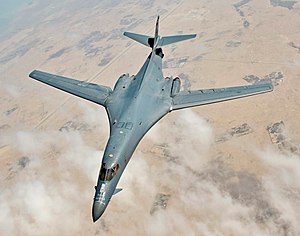
Back Rockwell B-1 Lancer Afrikaans Rockwell B-1 Lancer AN بي-1 لانسر Arabic Rockwell B-1 Lancer Azerbaijani Rockwell B-1 BE-X-OLD B-1 Bulgarian রকওয়েল বি-১ ল্যান্সার Bengali/Bangla Boeing B-1 BS Rockwell B-1 Lancer Czech Rockwell B-1 Lancer Danish
| B-1 Lancer | |
|---|---|

| |
| A B-1B in flight | |
| Role | Supersonic strategic heavy bomber |
| National origin | United States |
| Manufacturer | Original: North American Rockwell/Rockwell International Current contractor: Boeing[1] |
| First flight | 23 December 1974 |
| Introduction | 1 October 1986 |
| Status | In service |
| Primary user | United States Air Force |
| Produced | 1973–1974, 1983–1988 |
| Number built | 104[a] |
The Rockwell B-1 Lancer[b] is a supersonic variable-sweep wing, heavy bomber used by the United States Air Force. It has been nicknamed the "Bone" (from "B-One").[2][3] It is one of the Air Force's three strategic bombers, along with the B-2 Spirit and the B-52 Stratofortress, as of 2024[update]. Its 75,000-pound (34,000 kg) payload is the heaviest of any U.S. bomber.[4]
The B-1 was first envisioned in the 1960s as a bomber that would combine the Mach 2 speed of the B-58 Hustler with the range and payload of the B-52, ultimately replacing both. After a long series of studies, Rockwell International (B-1 division later acquired by Boeing) won the design contest for what emerged as the B-1A. Prototypes of this version could fly Mach 2.2 at high altitude and long distances at Mach 0.85 at very low altitudes. The program was canceled in 1977 due to its high cost, the introduction of the AGM-86 cruise missile that flew the same basic speed and distance, and early work on the B-2 stealth bomber.
The program was restarted in 1981, largely as an interim measure due to delays in the B-2 stealth bomber program. The B-1A design was altered, reducing top speed to Mach 1.25 at high altitude, increasing low-altitude speed to Mach 0.96, extensively improving electronic components, and upgrading the airframe to carry more fuel and weapons. Dubbed the B-1B, deliveries of the new variant began in 1985; the plane formally entered service with Strategic Air Command (SAC) as a nuclear bomber the following year. By 1988, all 100 aircraft had been delivered.
With the disestablishment of SAC and its reassignment to the Air Combat Command in 1992, the B-1B's nuclear capabilities were disabled and it was outfitted for conventional bombing. It first served in combat during Operation Desert Fox in 1998 and again during the NATO action in Kosovo the following year. The B-1B has supported U.S. and NATO military forces in Afghanistan and Iraq. As of 2021 the Air Force has 45 B-1Bs.[5] The Northrop Grumman B-21 Raider is to begin replacing the B-1B after 2025; all B-1s are planned to be retired by 2036.[6]
- ^ "B-1B Lancer". Air Force. Retrieved 13 February 2024.
- ^ a b Cite error: The named reference
Jenkins_p67was invoked but never defined (see the help page). - ^ Cohen, Rachel (24 September 2021). "Farewell, Bones: Air Force finishes latest round of B-1B bomber retirements". Air Force Times. Archived from the original on 8 February 2024. Retrieved 20 October 2023.
- ^ "B-1B Lancer". Air Force. Archived from the original on 31 January 2024. Retrieved 3 February 2024.
- ^ Losey, Stephen (24 September 2021). "Last of 17 Retired B-1s Sent to Boneyard as Air Force Preps for B-21s". Military.com. Archived from the original on 8 October 2021. Retrieved 9 October 2021.
- ^ "USAF to Retire B-1, B-2 in Early 2030s as B-21 Comes On-Line". Air Force Magazine. 11 February 2018. Archived from the original on 6 March 2018. Retrieved 5 March 2018.
Cite error: There are <ref group=lower-alpha> tags or {{efn}} templates on this page, but the references will not show without a {{reflist|group=lower-alpha}} template or {{notelist}} template (see the help page).
© MMXXIII Rich X Search. We shall prevail. All rights reserved. Rich X Search